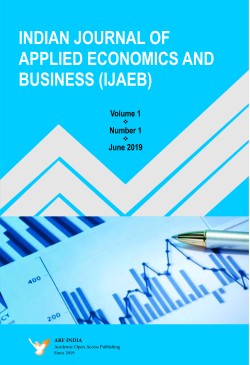
Indian Journal of Applied Economics and Business
Frequency :Bi-Annual
ISSN :2582-4325
Peer Reviewed Journal
What Factors Determine Family Spending on Education in India and Does It Vary across Well-being Measures?
Covid-19: Impact and Recovery of Hotel Industry in Malaysia
An Impact of Expenditure on Irrigation on Some Economic Indicators of Agriculture Sector in Haryana
Financial Development and CO2 Emission: An Empirical Analysis
Analysis of Worker’s Participation Rates in Local Governments of India – A Study Based on Several Census Years
Assessing the Socio-Economic Conditions of Pottery Artisans in Delhi and Haryana
Dikshika Jakhar (2023). Assessing the Socio-Economic Conditions of Pottery Artisans in Delhi and Haryana. Indian Journal of Applied Economics and Business. 5(2), 353-361. https://DOI:10.47509/IJAEB.2023.v05i02.6
Growth and Performance of KCC Scheme in India
Kuldeep Singh & Kavita Devi (2023). Growth and Performance of KCC Scheme in India. Indian Journal of Applied Economics and Business. 5(2), 363-371. https://DOI:10.47509/IJAEB.2023.v05i02.7
Navigating Economic Disparities: A Study on Higher Education Access and Challenges in Jammu District
Access to higher education remains a fundamental pillar for individual and societal progress, yet significant disparities and challenges persist across global and regional contexts. Despite the increasing importance of higher education in a knowledge-driven world, socioeconomic, geographic, and cultural barriers continue to restrict opportunities for many, particularly among marginalized and disadvantaged groups. This study aims to delve into the multifaceted relationship between higher education and economic inequality, with a focus on the factors influencing students’ choices in accessing higher education. Utilizing a mixed-methods approach, the study integrates both quantitative and qualitative data. Surveys and structured interviews are conducted in the Jammu district. The target population was graduate students, and 395 respondents were taken through stratified random sampling. The data is analyzed to understand the socio-economic variables, such as family income, parental education, and geographical location, that influence educational choices. Additionally, the research examines the role of economic inequalities in shaping access to higher education, emphasizing the barriers that economically disadvantaged students encounter. The results are expected to provide a comprehensive overview of how economic inequality affects educational access and highlight the various challenges students face, including financial constraints, lack of resources, and socio-cultural factors. The study
underscores the need for targeted policies and interventions to promote equitable access to higher education and mitigate the effects of economic disparities.
Keywords: socioeconomic status, inclusion, higher education, economic inequalities, occupation, income level.
JEL codes: I23, I24, I26, Q01, J24,
Preeti Devi & Falendra Kumar Sudan (2023). Navigating Economic Disparities: A Study on Higher Education Access and Challenges Jammu District. Indian Journal of Applied Economics and Business. 5(2), 373-399. https://DOI:10.47509/IJAEB.2023.v05i02.8